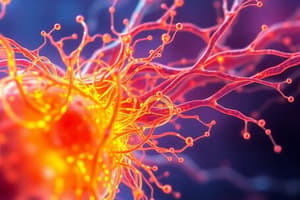Podcast
Questions and Answers
Which type of actin is present in non-muscle cells?
Which type of actin is present in non-muscle cells?
- α-actin
- ε-actin
- B- and γ-actin (correct)
- δ-actin
What is the monomer of microfilaments called?
What is the monomer of microfilaments called?
- M-actin
- F-actin
- G-actin (correct)
- T-actin
What do actin monomers assemble to form?
What do actin monomers assemble to form?
- Filamentous actin (F-actin) (correct)
- Intermediate filaments
- Myosin filaments
- Microtubules
How do two protofilaments form a microfilament?
How do two protofilaments form a microfilament?
How are microfilaments polarized?
How are microfilaments polarized?
What regulates the assembly, growing, or shortening of microfilaments?
What regulates the assembly, growing, or shortening of microfilaments?
What happens to ATP bound to G-actin after microfilament assembly?
What happens to ATP bound to G-actin after microfilament assembly?
What results in a difference in the critical concentration of monomers needed for polymerization at the two ends of microfilaments?
What results in a difference in the critical concentration of monomers needed for polymerization at the two ends of microfilaments?
In in vitro conditions, what do microfilaments assembly share the same features with?
In in vitro conditions, what do microfilaments assembly share the same features with?
Where does the nucleation of microfilaments (MFs) most frequently occur?
Where does the nucleation of microfilaments (MFs) most frequently occur?
What is the function of actin-bundling proteins?
What is the function of actin-bundling proteins?
What are the finger-like extensions formed by bundles of actin filaments called?
What are the finger-like extensions formed by bundles of actin filaments called?
What is the main function of pseudopodia?
What is the main function of pseudopodia?
What is the function of myosin molecular motors in cell movement?
What is the function of myosin molecular motors in cell movement?
Where are lamellipodia and filopodia located?
Where are lamellipodia and filopodia located?
What is the function of actin networks?
What is the function of actin networks?
What is the main function of microvilli in the small intestine?
What is the main function of microvilli in the small intestine?
What is the role of adhesion plaque in cell movement?
What is the role of adhesion plaque in cell movement?
What are the structures formed by tightly packed MFs into parallel arrays called?
What are the structures formed by tightly packed MFs into parallel arrays called?
What is the main function of filopodia?
What is the main function of filopodia?
What is the function of actin-binding proteins?
What is the function of actin-binding proteins?
Flashcards are hidden until you start studying
Study Notes
Actin in Non-Muscle Cells
- Non-muscle cells contain β-actin, the most common form of actin.
Microfilaments
- Actin monomers are called G-actin.
- G-actin monomers assemble to form F-actin, a polymer.
- Two protofilaments twist together to form a microfilament.
- Microfilaments are polarized, with a plus end and a minus end.
- The assembly, growth, and shortening of microfilaments are regulated by various factors, including ATP, ions, and actin-binding proteins.
Microfilament Assembly
- ATP bound to G-actin is hydrolyzed to ADP after microfilament assembly.
- A difference in critical concentration of monomers at the two ends of microfilaments results from the difference in ATP-ADP exchange rates.
In Vitro Conditions
- In vitro microfilament assembly shares the same features with in vivo conditions.
Microfilament Nucleation
- Microfilament nucleation most frequently occurs at the cell membrane.
Actin-Bundling Proteins
- Actin-bundling proteins bind to actin filaments and bundle them together.
Pseudopodia
- Finger-like extensions formed by bundles of actin filaments are called pseudopodia.
- The main function of pseudopodia is to sense the environment and facilitate cell movement.
Myosin Molecular Motors
- Myosin molecular motors use ATP hydrolysis to move along actin filaments, contributing to cell movement.
Lamellipodia and Filopodia
- Lamellipodia and filopodia are located at the leading edge of migrating cells.
- They are involved in cell migration and sensing the environment.
Actin Networks
- Actin networks provide mechanical support and shape to cells.
Microvilli
- The main function of microvilli in the small intestine is to increase the surface area for absorption.
Adhesion Plaque
- Adhesion plaques are specialized structures that connect the actin cytoskeleton to the extracellular matrix, facilitating cell movement.
Actin-Binding Proteins
- Actin-binding proteins regulate the dynamics and organization of actin filaments.
Stress Fibers
- Tightly packed microfilaments into parallel arrays are called stress fibers.
- They provide mechanical support and resist external forces.
Filopodia
- The main function of filopodia is to sense the environment and guide cell movement.
Studying That Suits You
Use AI to generate personalized quizzes and flashcards to suit your learning preferences.



